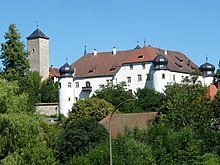Unteraufseß Castle
The Castle Unteraufseß (castle Aufseß) is a castle in Aufseß in the Upper Franconian district of Bayreuth . The facility is one of the oldest in Upper Franconia and probably dates back to the 11th century.
History and structure
The castle Aufseß on a hill in the village is the ancestral home of baronial family von und zu Aufseß . The name Unteraufseß was only used to distinguish it from Oberaufseß Castle , which was built in 1690 and located higher up , before that for centuries the complex was only called Aufseß Castle. Both castles are still family-owned and can be visited.
The first documentary mention comes from the year 1114, when a “liber homo” (free lord, ie noble free ) “Herolt de Ufsaze” was named as trustee of the Bamberg monastery of St. Jakob. The actual origin of the castle could go back to 1007. According to legend, a knight "Heinrich von Ufsaze" is said to have moved to Franconia this year with King Heinrich, who later became Emperor Heinrich II (from 1014). In fact, King Heinrich founded the Bamberg diocese in November 1007 and Aufseß Castle was possibly part of the protective belt that was supposed to protect the young diocese against incursions from the east.
The Middle High German name Ufsaze means 'to sit on (the rock)' and refers to the location of the keep . The current spelling "Aufseß" first appeared in a document in 1301. The keep on a rock, a square quarry stone tower with a tent roof, is the oldest surviving part of the complex. It was expanded into a refuge with further small additions .
The castle church, which was added later, the main building and the farm building are surrounded by a completely preserved castle wall. Until the Thirty Years War they were protected by another wall at the foot of the hill. The castle was affected by the Hussite invasion of Upper Franconia in January / February 1430, the Peasants 'War in spring 1525 and the Thirty Years' War . In 1677 the castle was restored after being destroyed and the east wing rebuilt. The separation of the family into a Protestant and a Catholic line led to tensions, especially during the reconstruction of the castle church.
Hans von und zu Aufseß set up a study in the preserved keep from around 1822. In the castle, a chapel that he furnished in a romanticizing style in 1840 provides information about the relationships and traditions of the family, including through a series of coats of arms of related families. The Hassfurt knight's chapel served as a model for the chapel .
The castle consists of a three-storey angled half-hipped roof and has three round corner towers with onion domes and a stair tower on the courtyard side. The Meingotzhaus is a two-story saddle roof building from the 12th century. Other buildings are the gate building, the former bailiwick, a two-storey saddle roof building, including a porch with half-timbered upper storey and hipped roof, designated 1883.
Illustrations
literature
- Kai Kellermann: Stately gardens in Franconian Switzerland - a search for traces . Verlag Palm & Enke, Erlangen and Jena 2008, ISBN 978-3-7896-0683-0 , pp. 238–241.
- Castle administration Aufseß (ed.): Castle Aufseß . Bayreuth 1988.
Web links
- Site of Unteraufseß Castle (Aufseß Castle)
- Unteraufseß Castle (Aufseß Castle) . In: Foracheim.de
Coordinates: 49 ° 52 ′ 58.7 " N , 11 ° 13 ′ 41.5" E













